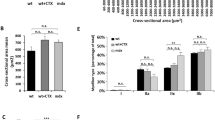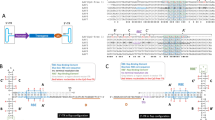Abstract
In utero gene delivery could offer the advantage of treatment at an early stage for genetic disorders such as Duchenne muscular dystrophy (DMD) in which the inevitable process of muscle degeneration is already initiated at birth. Furthermore, treatment of fetal muscle with adenoviral (Ad) vectors is attractive because of a high density of Ad receptors, easy vector accessibility due to immaturity of the basal lamina and the possibility of treating stem cells. Previously, we demonstrated the efficient transduction of fetal muscle by high-capacity Ad (HC-Ad) vectors. In this study, we compared HC-Ad and first-generation Ad (FG-Ad) vectors for longevity of lacZ transgene expression, toxicity and induction of immunity after direct vector-mediated in utero gene delivery to fetal C57BL/6 mice muscle 16 days after conception (E-16). The total amount of β-galactosidase (βgal) expressed from the HC-Ad vector remained stable for the 5 months of the study, although the concentration of βgal decreased due to muscle growth. Higher survival rates that reflect lower levels of toxicity were observed in those mice transduced with an HC-Ad vector as compared to an FG-Ad vector. The toxicity induced by FG-Ad vector gene delivery was dependent on mouse strain and vector dose. Animals treated with either HC-Ad and FG-Ad vectors developed non-neutralizing antibodies against Ad capsid and antibodies against βgal, but these antibodies did not cause loss of vector genomes from transduced muscle. In a mouse model of DMD, dystrophin gene transfer to muscle in utero using an HC-Ad vector restored the dystrophin-associated glycoproteins. Our results demonstrate that long-term transgene expression can be achieved by HC-Ad vector-mediated gene delivery to fetal muscle, although strategies of vector integration may need to be considered to accommodate muscle growth.
This is a preview of subscription content, access via your institution
Access options
Subscribe to this journal
Receive 12 print issues and online access
$259.00 per year
only $21.58 per issue
Buy this article
- Purchase on Springer Link
- Instant access to full article PDF
Prices may be subject to local taxes which are calculated during checkout







Similar content being viewed by others
References
Gilchrist SC, Ontell MP, Kochanek S, Clemens PR . Immune response to full-length dystrophin delivered to Dmd muscle by a high-capacity adenoviral vector. Mol Ther 2002; 6: 359–368.
Mitchell M et al. Long-term gene transfer to mouse fetuses with recombinant adenovirus and adeno-associated virus (AAV) vectors. Gene Therapy 2000; 7: 1986–1992.
Turkay A, Saunders T, Kurachi K . Intrauterine gene transfer: gestational stage-specific gene delivery in mice. Gene Therapy 1999; 6: 1685–1694.
Jerebtsova M, Batshaw ML, Ye X . Humoral immune response to recombinant adenovirus and adeno-associated virus after in utero administration of viral vectors in mice. Pediatr Res 2002; 52: 95–104.
Lipshutz GS, Flebbe-Rehwaldt L, Gaensler KM . Reexpression following readministration of an adenoviral vector in adult mice after initial in utero adenoviral administration. Mol Ther 2000; 2: 374–380.
Lipshutz GS et al. In utero delivery of adeno-associated viral vectors: intraperitoneal gene transfer produces long-term expression. Mol Ther 2001; 3: 284–292.
Schachtner S, Buck C, Bergelson J, Baldwin H . Temporally regulated expression patterns following in utero adenovirus-mediated gene transfer. Gene Therapy 1999; 6: 1249–1257.
Schneider H et al. Sustained delivery of therapeutic concentrations of human clotting factor IX – a comparison of adenoviral and AAV vectors administered in utero. J Gene Med 2002; 4: 46–53.
Yang EY et al. Persistent postnatal transgene expression in both muscle and liver after fetal injection of recombinant adenovirus. J Pediatr Surg 1999; 34: 766–772.
Waddington SN et al. In utero gene transfer of human factor IX to fetal mice can induce postnatal tolerance of the exogenous clotting factor. Blood 2003; 101: 1359–1366.
Bilbao R et al. Fetal muscle gene transfer is not enhanced by an RGD capsid modification to high-capacity adenoviral vectors. Gene Therapy 2003; 10: 1821–1829.
Kochanek S . High-capacity adenoviral vectors for gene transfer and somatic gene therapy. Hum Gene Ther 1999; 10: 2451–2459.
Jiang Z et al. CTLA4Ig delivered by high-capacity adenoviral vector induces stable expression of dystrophin in mdx mouse muscle. Gene Therapy 2004; 11: 1453–1461.
Chen HH et al. DNA from both high-capacity and first-generation adenoviral vectors remains intact in skeletal muscle. Hum Gene Ther 1999; 10: 365–373.
Camargo FD et al. Germline incorporation of a replication-defective adenoviral vector in mice does not alter immune responses to adenoviral vectors. Mol Ther 2000; 2: 496–504.
O'Hara AJ et al. The spread of transgene expression at the site of gene construct injection. Muscle Nerve 2001; 24: 488–495.
Pegoraro E et al. Genetic and biochemical normalization in female carriers of Duchenne muscular dystrophy: evidence for failure of dystrophin production in dystrophin-competent myonuclei. Neurology 1995; 45: 677–690.
Biermann V et al. Targeting of high-capacity adenoviral vectors. Hum Gene Ther 2001; 12: 1757–1769.
Wills KN et al. Development and characterization of recombinant adenoviruses encoding human p53 for gene therapy of cancer. Hum Gene Ther 1994; 5: 1079–1088.
Parks RJ et al. A helper-dependent adenoviurs vector system-removal of helper virus by cre-mediated excision of the viral packaging signal. Proc Natl Acad Sci USA 1996; 93: 13565–13570.
Bilbao R et al. Binding of adenoviral fiber knob to the coxsackievirus-adenovirus receptor is crucial for transduction of fetal muscle. Hum Gene Ther 2003; 14: 645–649.
Bouri K et al. Polylysine modification of adenoviral fiber protein enhances muscle cell transduction. Hum Gene Ther 1999; 10: 1633–1640.
MacKenzie TC et al. Efficient transduction of liver and muscle after in utero injection of lentiviral vectors with different pseudotypes. Mol Ther 2002; 6: 349–358.
Anderson RD et al. A simple method for the rapid generation of recombinant adenovirus vectors. Gene Therapy 2000; 7: 1034–1038.
Jiang ZL et al. Local high-capacity adenovirus-mediated mCTLA4Ig and mCD40Ig expression prolongs recombinant gene expression in skeletal muscle. Mol Ther 2001; 3: 892–900.
Lu QL, Partridge TA . A new blocking method for application of murine monoclonal antibody to mouse tissue sections. J Histochem Cytochem 1998; 46: 977–984.
Acknowledgements
We thank David Fink and Marina Mata (University of Pittsburgh, Pittsburgh, PA) for their contributions. We thank Merck & Co. Inc. for the helper virus AdLC8cluc and 293Cre4 cells that were used to grow AdmDys. This work was supported by NIH Grant P01 AR45925 (PRC), Muscular Dystrophy Association grants (PRC), and a postdoctoral fellowship grant from the Fundación Ramón Areces (RB).
Author information
Authors and Affiliations
Rights and permissions
About this article
Cite this article
Bilbao, R., Reay, D., Wu, E. et al. Comparison of high-capacity and first-generation adenoviral vector gene delivery to murine muscle in utero. Gene Ther 12, 39–47 (2005). https://doi.org/10.1038/sj.gt.3302392
Received:
Accepted:
Published:
Issue Date:
DOI: https://doi.org/10.1038/sj.gt.3302392
Keywords
This article is cited by
-
Improvement of the mdx mouse dystrophic phenotype by systemic in utero AAV8 delivery of a minidystrophin gene
Gene Therapy (2010)
-
Systemic delivery of AAV8 in utero results in gene expression in diaphragm and limb muscle: treatment implications for muscle disorders
Gene Therapy (2009)
-
Progress and prospects: gene therapy for genetic diseases with helper-dependent adenoviral vectors
Gene Therapy (2008)
-
Full-length dystrophin gene transfer to the mdx mouse in utero
Gene Therapy (2008)
-
Gutless adenovirus: last-generation adenovirus for gene therapy
Gene Therapy (2005)



